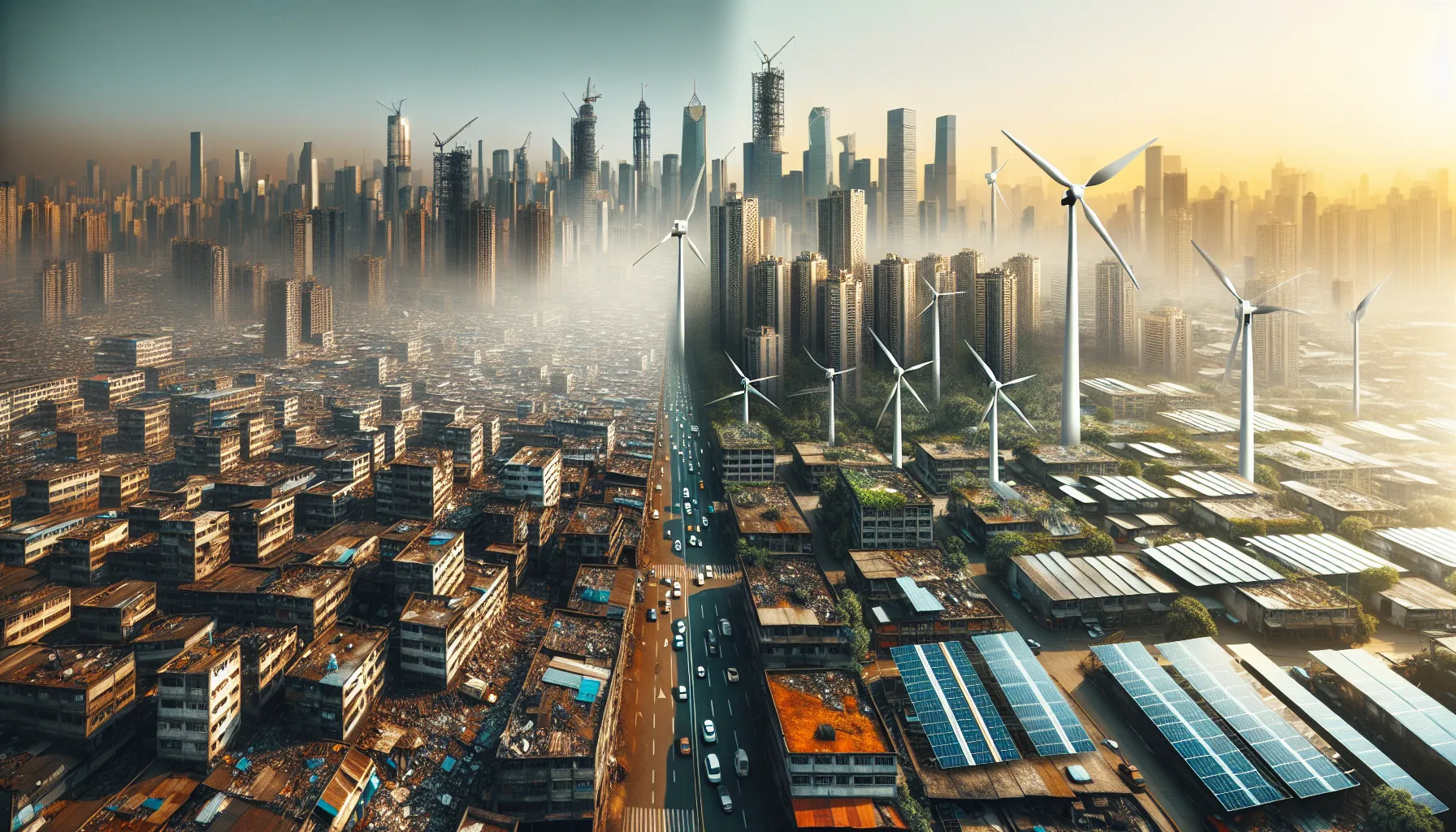Are you preparing for the IELTS Reading test and looking to improve your skills on environmental topics? Look no further! This comprehensive practice test focuses on how green energy is reducing air pollution in urban areas, a crucial subject in today’s world. As an experienced IELTS instructor, I’ve crafted this test to closely resemble the actual IELTS Reading exam, complete with passages of increasing difficulty and a variety of question types. Let’s dive in and enhance your reading comprehension while exploring this vital environmental issue.
 Green energy reducing urban air pollution
Green energy reducing urban air pollution
Passage 1 – Easy Text
The Rise of Green Energy in Cities
In recent years, urban areas have faced significant challenges due to air pollution, primarily caused by the burning of fossil fuels for energy production and transportation. However, a promising solution has emerged in the form of green energy. This renewable energy source is not only environmentally friendly but also plays a crucial role in reducing air pollution in cities worldwide.
Green energy encompasses various forms of clean power generation, including solar, wind, and hydroelectric energy. Unlike traditional energy sources, these renewable alternatives produce little to no emissions during operation, making them ideal for improving air quality in densely populated urban environments.
One of the most visible impacts of green energy in cities is the reduction of smog and particulate matter in the air. As more cities transition to renewable energy sources for power generation and public transportation, the levels of harmful pollutants in the atmosphere have begun to decrease. This shift not only improves the visual appearance of urban skylines but also has significant health benefits for city dwellers.
Solar panels on rooftops and wind turbines on the outskirts of cities are becoming increasingly common sights. These installations contribute to a decentralized power grid, reducing the reliance on large, centralized power plants that often burn fossil fuels. Additionally, many cities are investing in electric vehicle infrastructure, further reducing emissions from the transportation sector.
The adoption of green energy in urban areas also brings economic benefits. It creates jobs in the renewable energy sector and can lead to reduced energy costs for consumers in the long term. Moreover, cities that prioritize green energy often attract eco-conscious businesses and residents, contributing to overall urban development and sustainability.
As technology advances and the cost of renewable energy continues to decrease, the potential for green energy to transform urban environments grows. Many cities have set ambitious targets for renewable energy adoption, with some aiming to become entirely powered by clean energy sources in the coming decades.
In conclusion, the rise of green energy in cities represents a significant step towards combating air pollution and creating more sustainable urban environments. As this trend continues, we can expect to see cleaner air, improved public health, and a brighter future for our urban centers.
Questions 1-7
Do the following statements agree with the information given in the reading passage?
Write:
TRUE if the statement agrees with the information
FALSE if the statement contradicts the information
NOT GIVEN if there is no information on this
- Green energy sources produce significant emissions during operation.
- The transition to renewable energy in cities has led to a decrease in smog and particulate matter.
- Solar panels and wind turbines contribute to a centralized power grid.
- The adoption of green energy in urban areas creates job opportunities.
- All cities have set targets to be entirely powered by clean energy sources.
- Green energy is more expensive than traditional energy sources.
- The use of electric vehicles in cities contributes to reducing air pollution.
Questions 8-13
Complete the sentences below.
Choose NO MORE THAN TWO WORDS from the passage for each answer.
- Green energy is considered an environmentally friendly and ____ energy source.
- Three examples of green energy mentioned in the passage are solar, wind, and ____ energy.
- The reduction of smog and particulate matter in cities improves the ____ of urban skylines.
- Cities investing in green energy often attract ____ businesses and residents.
- Many cities have set ____ targets for adopting renewable energy.
- The rise of green energy in cities is creating more ____ urban environments.
Passage 2 – Medium Text
Green Energy Technologies Transforming Urban Air Quality
The implementation of green energy technologies in urban areas has become a cornerstone in the fight against air pollution. As cities grapple with the detrimental effects of poor air quality on public health and the environment, innovative solutions are being deployed to mitigate these issues. This transition to cleaner energy sources is not only reshaping the urban landscape but also significantly improving the air we breathe in our cities.
One of the most prominent green technologies making a difference in urban air quality is solar photovoltaic (PV) systems. These systems, which convert sunlight directly into electricity, are being installed on rooftops, parking lots, and even integrated into building facades. The proliferation of solar PV in urban areas has led to a marked reduction in the reliance on fossil fuel-powered electricity generation, subsequently decreasing the emission of harmful pollutants such as sulfur dioxide and nitrogen oxides.
Wind energy, while often associated with rural areas, is also finding its place in the urban environment through vertical axis wind turbines (VAWTs). These compact, less visually intrusive turbines are designed to operate efficiently in the turbulent wind conditions typical of city landscapes. By harnessing wind energy within the urban fabric, cities can further diversify their clean energy portfolio and reduce dependence on polluting power sources.
The transportation sector, a significant contributor to urban air pollution, is undergoing a green revolution of its own. The electrification of public transport systems, including buses and trains, is rapidly gaining momentum in cities worldwide. Electric vehicles (EVs) produce zero tailpipe emissions, leading to immediate improvements in local air quality. Moreover, as the electricity grid becomes greener, the overall environmental impact of these vehicles continues to diminish.
Biomass energy systems are another innovative solution being adopted in urban areas. These systems utilize organic waste from households, restaurants, and parks to generate heat and electricity. By repurposing waste that would otherwise end up in landfills, cities are not only reducing methane emissions but also creating a circular economy that supports cleaner air.
The integration of smart grid technologies is playing a crucial role in optimizing the use of green energy in urban environments. These advanced systems allow for better management of energy supply and demand, enabling cities to maximize the use of renewable sources when they are most abundant. This intelligent approach to energy distribution further reduces the need for fossil fuel-based backup power, contributing to cleaner air in urban areas.
Green building practices are also making a significant impact on urban air quality. The incorporation of energy-efficient designs, green roofs, and vertical gardens in new and retrofitted buildings helps to reduce overall energy consumption and filter air pollutants naturally. These living architectural elements not only improve air quality but also contribute to the aesthetic appeal and biodiversity of urban spaces.
As cities continue to invest in and adopt these green energy technologies, the cumulative effect on urban air quality becomes increasingly apparent. Reduced emissions from power generation and transportation, coupled with the air-purifying effects of green infrastructure, are creating cleaner, more livable urban environments. This transformation not only benefits current city dwellers but also sets a sustainable precedent for future urban development.
The journey towards cleaner urban air through green energy is ongoing, with new technologies and approaches constantly emerging. As these innovations continue to evolve and become more accessible, the potential for dramatic improvements in urban air quality grows. The success of these initiatives demonstrates that with commitment and innovation, cities can indeed breathe easier, paving the way for a healthier, more sustainable urban future.
Questions 14-19
Choose the correct letter, A, B, C, or D.
-
According to the passage, solar photovoltaic systems in urban areas have:
A) Increased reliance on fossil fuels
B) Reduced emissions of harmful pollutants
C) Been installed only on rooftops
D) Led to increased electricity costs -
Vertical axis wind turbines are suitable for urban environments because:
A) They are more efficient than traditional wind turbines
B) They are less visually intrusive
C) They can operate in turbulent wind conditions
D) Both B and C -
The electrification of public transport systems:
A) Has no impact on local air quality
B) Is only happening in a few cities
C) Leads to immediate improvements in air quality
D) Is too expensive for most cities to implement -
Biomass energy systems in cities:
A) Only use household waste
B) Increase methane emissions
C) Generate heat and electricity
D) Are not effective in reducing air pollution -
Smart grid technologies in urban areas:
A) Increase the need for fossil fuel-based backup power
B) Are not compatible with renewable energy sources
C) Optimize the use of green energy
D) Have no impact on air quality -
Green building practices contribute to urban air quality by:
A) Only focusing on energy efficiency
B) Increasing overall energy consumption
C) Filtering air pollutants naturally
D) Reducing biodiversity in urban spaces
Questions 20-26
Complete the summary below.
Choose NO MORE THAN TWO WORDS from the passage for each answer.
The implementation of green energy technologies in urban areas is playing a crucial role in combating air pollution. Solar PV systems installed on buildings have led to a reduction in (20) ____ emissions. In city landscapes, (21) ____ wind turbines are being used due to their compact design. The (22) ____ of public transport is gaining momentum, producing zero tailpipe emissions. (23) ____ systems are repurposing organic waste to generate power, creating a circular economy. The integration of (24) ____ allows for better management of energy supply and demand. (25) ____ incorporate energy-efficient designs and natural air filters, contributing to improved air quality. As cities adopt these technologies, the (26) ____ on urban air quality becomes increasingly evident.
Passage 3 – Hard Text
The Synergistic Effect of Green Energy Policies on Urban Air Quality
The paradigm shift towards green energy in urban environments has catalyzed a multifaceted approach to combating air pollution, encompassing technological innovations, policy frameworks, and socio-economic transformations. This holistic strategy has engendered a synergistic effect, whereby the collective impact of various green energy initiatives surpasses the sum of their individual contributions to air quality improvement. The intricate interplay between these elements has precipitated a profound metamorphosis in urban landscapes, heralding a new era of sustainable development and environmental stewardship.
At the crux of this transformation lies the symbiotic relationship between renewable energy technologies and urban planning paradigms. The integration of distributed energy resources, such as rooftop solar arrays and small-scale wind turbines, into the urban fabric has not only democratized energy production but also engendered a more resilient and adaptive energy infrastructure. This decentralization of power generation has concomitantly reduced the reliance on large-scale, centralized fossil fuel plants, which have historically been major contributors to urban air pollution.
The proliferation of electric vehicles (EVs) in urban settings, coupled with the greening of the electricity grid, has engendered a virtuous cycle of air quality improvement. As the proportion of renewable energy in the grid increases, the well-to-wheel emissions of EVs concomitantly decrease, amplifying their positive impact on urban air quality. This synergy between clean transportation and renewable energy generation exemplifies the multiplicative effect of integrated green energy policies.
Moreover, the advent of smart city technologies has facilitated the optimization of energy consumption patterns in urban areas. Advanced metering infrastructure and Internet of Things (IoT) devices enable real-time monitoring and management of energy demand, allowing for more efficient utilization of renewable energy sources. This dynamic load balancing not only enhances the stability of the grid but also minimizes the need for polluting peaker plants during periods of high demand.
The implementation of green building standards and energy efficiency regulations has engendered a paradigm shift in urban architecture and design. Passive solar design, thermal insulation, and energy-efficient HVAC systems have significantly reduced the energy consumption of buildings, which account for a substantial portion of urban energy demand. The resultant decrease in energy requirements has, in turn, diminished the pressure on power generation systems, indirectly contributing to improved air quality.
The circular economy principles applied to urban waste management have yielded unexpected benefits for air quality. Waste-to-energy facilities and biogas plants not only mitigate methane emissions from landfills but also provide a renewable source of energy, further reducing the reliance on fossil fuels. This integrated approach to waste management and energy production exemplifies the potential for innovative solutions to address multiple urban challenges simultaneously.
Urban greening initiatives, such as the creation of parks, green corridors, and vertical gardens, play a dual role in improving air quality. While these green spaces act as natural carbon sinks and particulate matter filters, they also contribute to the mitigation of the urban heat island effect. The resultant reduction in cooling energy demand during summer months further diminishes the strain on the power grid, creating a positive feedback loop that enhances overall air quality.
The economic implications of this green energy transition are profound and multifaceted. The burgeoning clean energy sector has become a significant source of employment, fostering economic resilience and social equity. Furthermore, the improved air quality resulting from these initiatives has led to substantial public health benefits, reducing healthcare costs and enhancing productivity. This economic dividend has, in turn, enabled further investments in green infrastructure, perpetuating a cycle of sustainable urban development.
However, the transition to green energy in urban areas is not without its challenges. The intermittent nature of renewable energy sources necessitates the development of advanced energy storage solutions and smart grid technologies to ensure grid stability. Additionally, the retrofitting of existing urban infrastructure to accommodate these new technologies poses significant logistical and financial hurdles.
In conclusion, the synergistic effect of green energy policies on urban air quality represents a paradigm shift in our approach to urban sustainability. The intricate interplay between technological innovation, policy frameworks, and socio-economic factors has engendered a transformative process that transcends the mere substitution of energy sources. As cities continue to evolve and adapt to these new paradigms, the potential for creating truly sustainable, resilient, and healthy urban environments becomes increasingly tangible. The journey towards clean urban air through green energy is not merely a technological endeavor but a holistic reimagining of urban life in the 21st century.
Questions 27-32
Choose the correct letter, A, B, C, or D.
-
The passage suggests that the impact of green energy initiatives on urban air quality is:
A) Limited to technological innovations
B) Primarily driven by policy frameworks
C) A result of the combined effect of various factors
D) Mainly due to socio-economic transformations -
The integration of distributed energy resources in urban areas has:
A) Increased reliance on centralized power plants
B) Led to a less resilient energy infrastructure
C) Democratized energy production
D) Reduced the adaptability of the power grid -
According to the passage, the relationship between electric vehicles and the greening of the electricity grid:
A) Has no impact on urban air quality
B) Creates a virtuous cycle of air quality improvement
C) Decreases the efficiency of EVs
D) Increases well-to-wheel emissions -
Smart city technologies contribute to air quality improvement by:
A) Increasing energy consumption in urban areas
B) Reducing the need for renewable energy sources
C) Enabling more efficient use of energy
D) Promoting the use of peaker plants -
The implementation of green building standards has:
A) Increased the energy consumption of buildings
B) Had no effect on urban energy demand
C) Indirectly contributed to improved air quality
D) Increased pressure on power generation systems -
Urban greening initiatives:
A) Only act as carbon sinks
B) Increase the urban heat island effect
C) Have no impact on energy demand
D) Serve multiple functions in improving air quality
Questions 33-40
Complete the summary below.
Choose NO MORE THAN THREE WORDS from the passage for each answer.
The synergistic effect of green energy policies on urban air quality involves a complex interplay of various factors. The integration of (33) ____ into urban areas has led to a more resilient energy infrastructure. The combination of electric vehicles and a greener electricity grid creates a (34) ____ of air quality improvement. (35) ____ enable real-time monitoring and management of energy demand, optimizing the use of renewable sources. (36) ____ have significantly reduced the energy consumption of buildings. The application of (37) ____ principles to waste management has provided additional renewable energy sources. Urban greening initiatives contribute to air quality improvement by acting as natural filters and mitigating the (38) ____. The economic benefits of this transition include job creation and (39) ____, which enable further investments in green infrastructure. However, challenges remain, such as the need for advanced (40) ____ to ensure grid stability with intermittent renewable sources.
Answer Key
Passage 1
-
FALSE
-
TRUE
-
FALSE
-
TRUE
-
NOT GIVEN
-
NOT GIVEN
-
TRUE
-
renewable
-
hydroelectric
-
visual appearance
-
eco-conscious
-
ambitious
-
sustainable
Passage 2
- B
- D
- C
17


